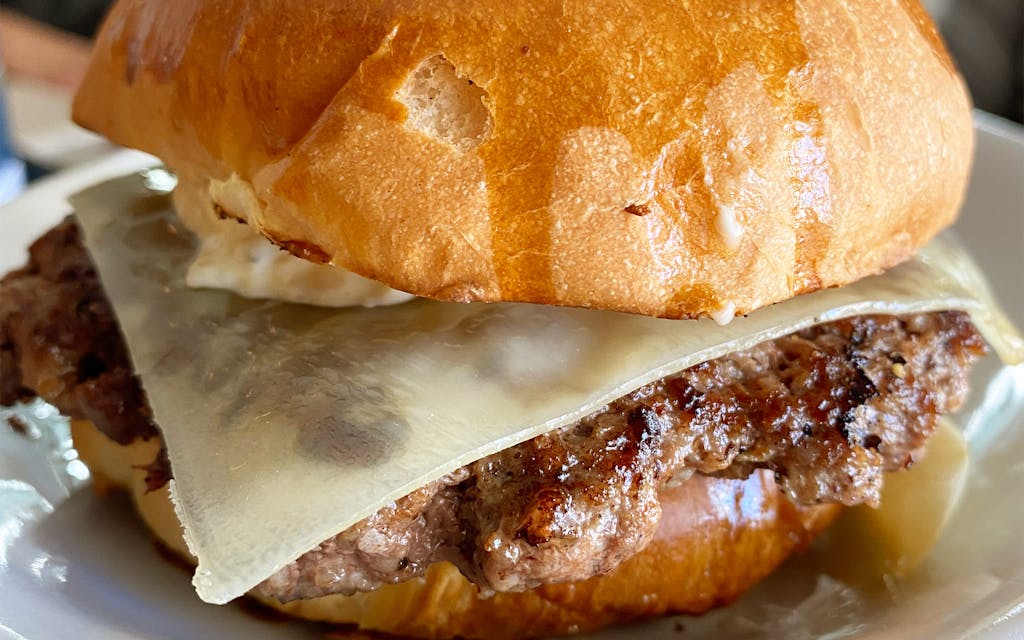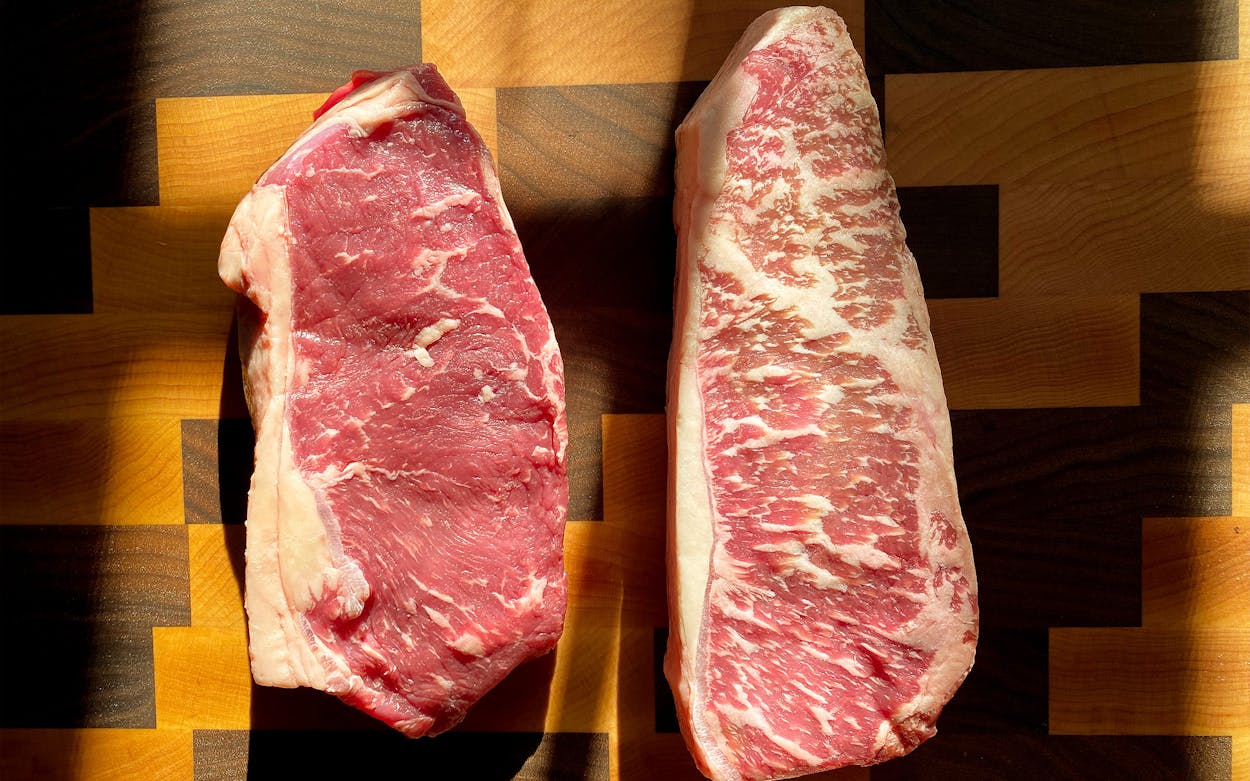The Peeler name is connected to various cattle operations south of San Antonio. There’s A. M. Peeler Ranch, in Christine, a sixth-generation cattle ranch founded in 1882 that’s owned by Alonzo and Barbara Peeler and their son Jason. In 2014, Jason partnered with Dustin Dean on Dean & Peeler Premium Angus Beef, in Floresville, in 2014, and they have their own USDA-inspected processing facility, in Poth, called Dean & Peeler Meatworks. Out east of Floresville, you’ll find the several hundred head of Akaushi cattle, on three thousand acres, that make up the Peeler Farms Wagyu herd.
The last is the brainchild of Jason and his wife, Marianna. They introduced Wagyu genetics into their existing herd of Angus cattle back in 2007. Through crossbreeding and the purchase of additional Akaushi (a specific type of Wagyu) bulls and breeding stock, they grew a herd of both purebred (at least fifteen-sixteenths Wagyu) and full-blood (only Japanese bloodlines) Wagyu cattle. Two years later, Marianna started Peeler Farms as a chicken-and-egg operation, but the couple decided to focus completely on Wagyu beef in 2014, once they had grown their herd. The company has been focused on both grain- and grass-fed Wagyu beef ever since.
I’ve written about several Texas Wagyu producers, and Peeler Farms is unique in a few ways. It sells beef only from 100 percent Wagyu cattle, rather than from F1 cattle, which are half Wagyu and half another breed, like Angus or Charolais. The Peelers sell only beef, not their breeding stock, and they raise it all themselves, rather than contracting with other ranchers. Peeler Farms is a fully vertically integrated beef operation, with the ranch and the feedlot on the same property. The animals are processed on the family’s Dean & Peeler Meatworks, which is the only federally inspected beef slaughter facility between Dallas and Corpus Christi. The family sells the beef in its own meat market in La Vernia and a partner market in Robstown and delivers it to restaurants (full list here) in a refrigerated van.
“It’s really very personal,” Marianna told me. She builds relationships with chefs and can offer them personalized service based on the cuts they want. But this is all possible because of how small her operation is. Her head cowboy, Brad McDougal, asks her every week how many cattle she’ll need to fill her orders. These days it’s usually just seven grain-fed and two grass-fed cattle. “I’m still a pretty boutique-type venture, and on purpose, and I’ll stay that way forever,” Marianna said. She would like Peeler Farms to grow, but the question is whether to focus her marketing efforts on the grass-fed aspect, the Wagyu genetics, or both.

“The problem is now everyone is in the Wagyu business,” Marianna said, only half joking. At the start of this century, Wagyu wasn’t just a boutique beef brand, it was basically a speakeasy. Fast-forward to 2019, when the largest beef company in the world, JBS, added a Wagyu line when it purchased Imperial American Wagyu Beef. The airwaves have been infested with advertisements for the new Wagyu Steakhouse Burger from Arby’s, which is just 51 percent Wagyu beef. The association with fast food makes the Wagyu name lose a bit of luster. “I’ve got to think of a way to be different,” Marianna told Jason the first time they watched one of the ads. And maybe that’s with grass-fed Wagyu cattle, which Marianna says are easier and less costly to raise than their grain-fed counterparts.
When the cattle are about sixteen months old, the Peelers perform an ultrasound on every one of them to determine their marbling up to that point. Those with the best potential for adding more intramuscular fat—usually about 90 percent of the herd—are sent to the feedlot for three hundred days of grain-feeding. The others are left in the pasture to eat nothing but grass for another year or more. The grass-fed cattle take a little longer to mature, but no expense is required to fatten them. Then again, they don’t get quite as fat.
Most grass-fed Wagyu on the market is imported from New Zealand and Australia. One of the most prominent producers of American Wagyu beef, Snake River Farms, based in Boise, Idaho, doesn’t offer grass-fed beef. One hurdle Marianna understands from selling her own beef is that grass-fed doesn’t look like the generic idea of Wagyu beef. It’s just not marbled like the meat in a photo of a Wagyu ribeye—more white than red, from all that fat—you might find in a glossy magazine advertisement. For that reason, she said, “there’s a bigger market for grass-fed ground beef that’s Wagyu than there is for steak.” Of all her restaurant customers, only one—Dai Due, in Austin—regularly orders grass-fed beef of any kind. “The most grass-fed inquiries I get are from meat markets,” she said. Although Marianna has several loyal grass-fed customers, most of the beef that comes off her grass-fed cattle becomes ground beef.
“When people ask what I do, I say I’m a hamburger salesman,” Marianna said, which is true for both the grain- and grass-fed beef. There are only so many ribeyes, tenderloins, and briskets on an animal. Besides, Marianna said, “I don’t think there’s a better burger than a Wagyu hamburger.” She sent me home with a couple pounds to prove the point. I cooked up some of the Peeler Farms grass-fed Wagyu patties alongside some of the grain-fed ground beef and found them both spectacular. There was a richness from the fat, which has the same qualities no matter the feed, and the grass-fed burgers didn’t have the mineral or gamy favor often associated with grass-fed beef from other breeds. And neither did the steaks.
Along with the ground beef, I also flew home with some frozen steaks (after a brief inspection at the TSA checkpoint) from both the grain- and grass-fed Wagyu cattle. The difference in marbling was obvious in three raw ribeyes. The grain-fed steak was loaded with white specks of fat. One of the grass-fed steaks was nearly all red, and one of the better grass-fed steaks—handpicked by Marianna—looked slightly more marbled. Upon inspection, I wouldn’t have expected to pay any more for it than for a cheap Select-grade steak at the grocery store, but then I cooked the ribeyes and tasted them together. I’ve tried plenty of grass-fed steaks. Even in small bites, they generally require lots of chewing, but the Peeler Farms beef was different. The natural tenderness from the Wagyu genetics made up for the marbling, and the meat retained an unexpected juiciness. That, combined with the clean, beefy flavor, made it the best domestically raised grass-fed steak I’ve eaten.
As for the grain-fed Wagyu, you won’t have to cook it yourself to enjoy it. In Austin, Peeler Farms supplies beef to Pool Burger, Sour Duck Market, and the aforementioned Dai Due and Salt & Time (among others). The lunch burger at Cured, in San Antonio, also uses Peeler Farms beef, but Marianna said I should visit Cullum’s Attaboy, along the St. Mary’s Strip in San Antonio, for a taste of its bavette steak and a couple burger options. The steak with perfectly fluffy eggs was a stunner, and I was taken by the beefy simplicity of the cheeseburger on a fresh-baked bun, especially with a side of Cullum’s impeccable fries.
More of those burger options are necessary for Peeler Farms to increase its processing numbers. “If I can’t sell the whole animal, I can’t slaughter it,” Marianna said, adding, “It’s really important to me that I don’t just kill cattle to sell ribeyes.” The irony is that if more people could try a grass-fed ribeye like the one I had at home, they’d likely demand more of that grass-fed ground beef too. Or you could just email Marianna (marianna@peelerfarms.com) to ask her for some of both, because that’s the kind of service you can get from a boutique beef rancher in Texas.
- More About:
- The Wild West of Wagyu
- Cattle








